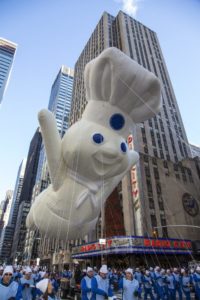A Parade of Intellectual Property: What We Can Learn From the Macy’s Thanksgiving Day Parade®
Posted on Nov 24, 2021 in Articles
While Philadelphia may lay claim to the nation’s oldest Thanksgiving Day parade, the Macy’s Thanksgiving Day Parade® is the most televised and well-known of Thanksgiving traditions, next to the turkey itself. Since 1924, the parade has marched down 34th Street, with the character balloons we have come to know and love first introduced in 1928. While the earliest balloons were common animals, including an elephant, tiger, and hummingbird, modern viewers have become used to sipping their morning coffee with Astronaut Snoopy®, the Pillsbury® Doughboy®, and SpongeBob SquarePants®.
But the annual parade is far more than colossal balloons and the highly anticipated performance from the Rockettes®. It is an advertiser’s paradise, a literal parade of intellectual property with a guaranteed national audience. The modern version of the parade has evolved far beyond a trademark showcase and has embraced music and even fine art, bringing copyright issues into the mix. With hundreds of intellectual property rights at play—far from a light lift to coordinate—viewers may wonder, how does it all come together?
In 1998, the United States Patent and Trademark Office granted Macy’s® a trademark registration for MACY’S THANKSGIVING DAY PARADE®, for “entertainment services, namely, organizing and conducting a parade.” For companies participating in the parade, each company sponsoring a balloon or float pays the cost of construction and a parade fee, amounting to nearly $200,000 for balloons and anywhere in the range of $30,000-$100,000 for floats [1]. Why do companies foot such a large bill? To garner goodwill.
The requirements for a trademark are (1) use in commerce and (2) distinctiveness. To be distinctive, the mark may be inherently distinctive, or it could acquire distinctiveness, known as “secondary meaning” [2]. A mark has acquired distinctiveness when there is “proof that it has become distinctive as applied to the applicant’s goods and services in commerce” [3]. However, if a distinctive mark loses its distinctiveness and becomes generic—a term commonly referred to as “genericide”—a trademark owner could lose its rights (think: Aspirin). Ultimately, trademarks protect the “goodwill” of a trademark, preventing others from taking advantage of any positive reputation a company has built around its brand [4].
By purchasing a balloon or float for the Macy’s Thanksgiving Day Parade®, a company 1) receives nationwide exposure, 2) is positively associated with a family tradition, and 3) gains recognition for its trademarks, causing the public to associate that mark with that company as the source of a certain quality of goods or services. All of these things not only enhance trademark distinctiveness, deterring genericide, but also create goodwill surrounding the trademarks, making them more valuable.
Copyright also has its place in the parade, as music soundtracks the three hour spectacle, choreography is performed, and fine art has made its way into floats and balloons. Copyright protects, among other things, musical works, dramatic works and accompanying music, choreographic works, pictorial, graphic, or sculptural works, and sound recordings, all of which appear on the Thanksgiving Day broadcast [5]. In 2019, Yayoi Kusama became the first female artist commissioned to create a balloon for the parade’s “Blue Sky Gallery” series, titled “Love Flies Up to the Sky,” a derivative work of her previous painting series titled “My Eternal Soul.” The balloon, a red, tentacled sun, is a floating sculpture and copyrightable subject matter [6]. Licensing deals also must be solidified between record labels and choreographers and/or production companies. Not to mention, NBC® acquired the broadcasting rights for the parade, meaning NBC® has a reproduction right for each piece of copyrightable subject matter appearing in the parade. [7]
While Macy’s® performs this parade of IP on a grander scale, what can event organizers learn from the Thanksgiving Day Parade?
- If the public event will include non-original music, inquire into receiving a public performance license to legally play the song in a public space;
- If the public event will include performances, a public performance license may be necessary regarding any choreography, dramatic works, and/or the accompanying music;
- If costuming is involved, and there is copyrightable subject matter that is separable from the shape, or utilitarian, aspect of the clothing, a license may be necessary for the costuming; and
- If the event is being broadcasted or streamed and the event contains copyrightable matter, the event organizer should acquire broadcasting rights.
While many think that coordinating Intellectual Property only exists for events of Macy’s® magnitude, these considerations can apply to business launch parties, streaming one’s own wedding, or community events. What we can learn from the Macy’s Thanksgiving Day Parade® is that coordinating IP can be complicated, but not if you know what rights are implicated. For more information on IP licensing, please visit www.caesar.law.
[1] Laura Woods, How much does a float in Macy’s Thanksgiving Day Parade cost?, CBS News (Nov. 28, 2019), https://www.cbsnews.com/news/thanksgiving-day-2019-parade-float-costs/.
[2] TMEP § 1212 (citing 15 U.S.C. 1052).
[3] Id.
[4] See TMEP 1203.03(b)(i) (explaining how goodwill impacted by falsely suggesting connection with source of goods or services).
[5] 17 U.S.C. § 102.
[6] See id.
[7] Copyright Act of 1957 § 37 (1957).


